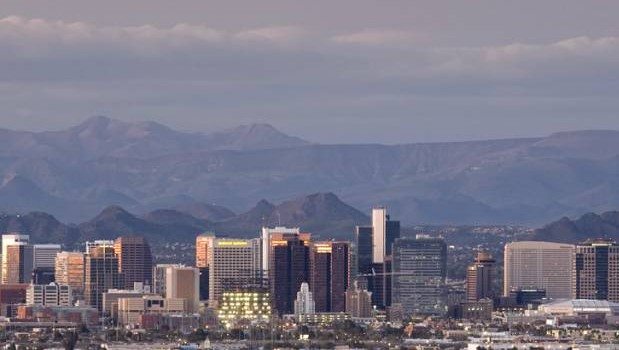The American Lung Association’s “State of the Air 2015” report shows that while Maricopa County improved year-round particle pollution levels there were more days spent with unhealthy levels of ozone and short-term particle pollution than last year’s report. Compared to the 2014 report, Maricopa County has cut year-round particle pollution (soot) levels slightly. This is in keeping with a trend seen across the nation of lower particle pollution levels. Maricopa County has also experienced more unhealthy days of high ozone (smog) and more days when short-term particle pollution has reached unhealthy levels.
Nationwide, more than 4 in 10 Americans – nearly 138.5 million people – live in counties where ozone or particle pollution levels make the air unhealthy to breathe, according to “State of the Air 2015.” The 16th annual national report card, which looks at air pollution data collected from 2011-2013, shows that improvement in the nation’s air quality was mixed, with many cities experiencing strong improvements, while others suffered increased episodes of unhealthy air, and a few even marked their worst number of unhealthy days.
“Maricopa County can certainly be proud of the progress we’ve made in cleaning up our air since the first ‘State of the Air’ report 16 years ago. However, there’s still a lot of work to be done to make our air healthy for all of us to breathe,” said Julie Reid, Executive Director, American Lung Association in Arizona.
“We can thank cleaner diesel fleets and cleaner power plants for the continued reduction of year-round particle pollution. However, the increase in unhealthy days of high ozone and short-term particle pollution continues to be a struggle for our community, especially for those with lung disease, like asthma or COPD,” said Reid. “Reducing pollution will only become more challenging because warmer temperatures increase the risk for ozone and particle pollution, and make cleaning up the air harder in the future. We need stronger air quality standards to limit pollution and continued cleanup of the current sources of pollution in to protect the health of our citizens.”
The 2015 report shows that Maricopa County reduced its year-round particle pollution, earning a passing grade. Maricopa County received “F” grade for short-term particle pollution, because of too many days of unhealthy particle levels. Particle pollution levels can spike dangerously for hours to weeks on end (short-term) or remain at unhealthy levels on average every day (year-round). Particle pollution can penetrate deep into the lungs and even into the bloodstream, leading to premature deaths, asthma attacks and heart attacks, as well as lung cancer.
“State of the Air 2015” also finds that Maricopa County’s ozone levels worsened, resulting in an “F” grade where peak levels from the metro area are monitored. Ozone is the most widespread air pollutant, created by the reaction of sunlight on emissions from vehicles and other sources. When ozone is inhaled, it irritates the lungs, like a bad sunburn. It can cause immediate health problems and continue days later. Ozone can cause wheezing, coughing, asthma attacks and premature death.
“We know that the Clean Air Act works because we’ve seen Maricopa County’s air quality improve over the past 16 years and seen the health benefits that have come with cleaning up the air,” said Reid. “EPA must move forward to fully implement the Clean Air Act for all pollutants that threaten public health, including finalizing a strong Clean Power Plan to limit carbon pollution from power plants and stronger ozone air quality standards. Congress must also ensure that the provisions under the Clean Air Act are protected, implemented and enforced. The EPA and every state must have adequate funding to monitor and protect our citizens from air pollution and new threats caused by increased temperatures.”
More Safeguards Needed to Protect Health
The American Lung Association calls for several steps to safeguard the air everyone breathes:
- Strengthen the outdated ozone standards. The EPA must adopt an up-to-date ozone limit that follows the current health science and the law to protect human health. Strong standards will drive much needed cleanup of ozone pollution across the nation.
- Adopt a strong final Clean Power Plan. The EPA needs to issue tough final requirements to reduce carbon pollution from power plants.
- Protect the Clean Air Act. Congress needs to ensure that the protections under the Clean Air Act remain effective and enforced. States should not be allowed to “opt out” of Clean Air Act protections.
- Fund the work to provide healthy air. Congress needs to adequately fund the work of the EPA and the states to monitor and protect the nation from air pollution.
To see how your community ranks in “State of the Air 2015,” to learn how to protect yourself and your family from air pollution, and to join the fight for healthy air, visit: www.StateOfTheAir.org.
Background
The American Lung Association “State of the Air 2015” report uses the most recent quality-assured air pollution data, collected by federal, state and local governments and tribes in 2011, 2012, and 2013. These data come from official monitors for the two most widespread types of pollution, ozone and particle pollution. The report grades counties, ranking cities and counties based on scores calculated by average number of unhealthy days (for ozone and for short-term particle pollution) and by annual averages (for year-round particle pollution).




